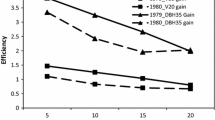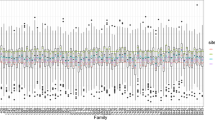Abstract
We reviewed the genetic parameter estimates carried out from 1992 to 2006 for height increment in genetic tests of Norway spruce and Scots pine, to describe patterns of genetic variation, heritability, and genetic correlations. The material included seedling and clonal tests in Sweden, aged between 5 and 20 years. Multiple regression was used to explore relationships between parameter values and test environments. Results showed moderate narrow-sense heritabilities (\( {\hat{h}^2} \): mean =0.29 in Norway spruce; mean =0.23 in Scots pine) that decreased with test site latitude for both species. In Norway spruce, \( {\hat{h}^2} \) increased with better growth and decreased with tree age, while for Scots pine, \( {\hat{h}^2} \) increased with tree age and southward transfer. The additive genetic coefficient of variation ( ; mean 15%), in Norway spruce, decreased with growth as well as site latitude.
; mean 15%), in Norway spruce, decreased with growth as well as site latitude.  in Scots pine (mean =8.5%) increased with southward transfer and more southerly test latitude. Additive and genotypic within-site genetic age-age correlations in Norway spruce were high, with mean r
A
and r
G
of 0.92 and 0.85, respectively. Corresponding across-sites estimates were on average lower. Genetic parameters were better expressed on favorable sites, at younger ages in Norway spruce and at older ages in Scots pine. The results imply that gain calculations should be based on different parameters in the two species. For maximizing genetic gain in the Swedish breeding program, testing times could be shorter for Norway spruce than for Scots pine. The investigation showed a large variation in parameter estimates from different field experiments, highlighting the importance of testing over multiple sites.
in Scots pine (mean =8.5%) increased with southward transfer and more southerly test latitude. Additive and genotypic within-site genetic age-age correlations in Norway spruce were high, with mean r
A
and r
G
of 0.92 and 0.85, respectively. Corresponding across-sites estimates were on average lower. Genetic parameters were better expressed on favorable sites, at younger ages in Norway spruce and at older ages in Scots pine. The results imply that gain calculations should be based on different parameters in the two species. For maximizing genetic gain in the Swedish breeding program, testing times could be shorter for Norway spruce than for Scots pine. The investigation showed a large variation in parameter estimates from different field experiments, highlighting the importance of testing over multiple sites.









Similar content being viewed by others
References
Apiolaza LA, Gilmour AR, Garrick DJ (2000) Variance modelling of longitudinal height data from a Pinus radiata progeny test. Can J For Res 30:645–654
Balocchi CE, Bridgwater FE, Zobel BJ, Jahromi S (1993) Age trends in genetic parameters for tree height in a nonselected population of loblolly pine. For Sci 39:231–251
Burdon RD (1977) Genetic correlation as a concept for studying genotype–environment interaction in forest tree breeding. Silvae Genet 26:168–175
Cornelius J (1994) Heritabilities and additive genetic coefficients of variation in forest trees. Can J For Res 24:372–379
Cotterill PP, Dean CA (1987) Changes in the genetic control of growth in radiata pine to 16 years and efficiencies of early selection. Silvae Genet 37:138–146
Ericsson T (1999) The effect of pedigree error by misidentification of individual trees on genetic evaluation of a full-sib experiment. Silvae Genet 5:239–242
Eriksson G (2008) Pinus sylvestris: Recent Genetic Research. Department of Plant Biology and Forest Genetics, Genetic Center, SLU, Box 7080, SE 750 07 Uppsala, Sweden
Eriksson G (2010) Picea abies: Recent Genetic Research. Department of Plant Biology and Forest Genetics, Genetic Center, SLU, Box 7080, SE 750 07 Uppsala, Sweden
Foster GS (1986) Trends in genetic parameters with stand development and their influence on early selection for volume growth in loblolly pine. For Sci 32:944–959
Franklin EC (1979) Model relating levels of genetic variance to stand development of four North American conifers. Silvae Genet 28:207–212
Gapare WJ, Ivković M, Baltunis BS, Matheson CA, Wu HX (2010) Genetic stability of wood density and diameter in Pinus radiata D. Don plantation estate across Australia. Tree Genet Genom 6:113–125
Giertych M, Mátyás C (eds) (1991) Genetics of Scots pine. Elsevier, Amsterdam
Greaves BL, Borralho NMG, Raymond CA, Evans R, Whiteman P (1997) Age–age correlations in, and relationships between, basic density and growth in Eucalyptus nitens. Silvae Genet 46:264–270
Gwaze DP, Bridgwater FE (2002) Determining the optimum selection age for diameter and height in loblolly pine. For Gen 9:159–165
Haapanen M (2001) Time trends in genetic parameter estimates and selection to field testing method. For Gen 8:129–144
Haapanen M, Velling P, Annala M-L (1997) Progeny trial estimates of genetic parameters for growth and quality traits in Scots pine. Silva Fenn 31:3–12
Hannrup B, Ekberg I, Persson A (2000) Genetic correlations between wood, growth capacity and stem traits in Pinus sylvestris. Scand J For Res 15:161–170
Hannrup B, Jansson G, Danell Ö (2008) Genotype by environment interaction in Pinus sylvestris L. in southern Sweden. Silvae Genet 57:306–311
Hodge GR, White TL (1992) Genetic parameter estimates for growth traits at different ages in slash pine and some implications for breeding. Silvae Genet 41:252–262
Hühn M, Kleinschmidt J (1993) Time trends in age–age covariances and correlations – examples from Norway spruce clones. Silvae Genet 42:175–179
Jansson G, Li B, Hannrup B (2003) Time trends in genetic parameters for height and optimal age for parental selection in Scots pine. For Sci 49:696–705
Johnson GR, Sniezko RA, Mandel NL (1997) Age trends in Douglas-fir genetic parameters and implications for optimum selection age. Silvae Genet 46:349–358
Kusnandar D, Galwey NW, Hertzler GL, Butcher TB (1998) Age trends in variances and heritablities for diameter abd height in Maritime pine (Pinus pinaster AIT.) in Western Australia. Silvae Genet 47:136–138
Lambeth C (1980) Juvenile–mature correlations in Pinaceae and implications for early selection. For Sci 26:571–580
Lambeth C, Dill LA (2001) Prediction models for juvenile–mature correlations for loblolly pine growth traits within, between and across test sites. For Gen 8:101–108
Langlet O (1936) Studier över tallens fysiologiska variabilitet och dess samband med klimatet. Stockholm. (Meddelande från Statens Skogsförsöksanstalt 1936:29)
Li L, Wu HX (2005) Efficiency of early selection for rotation-aged growth and wood density traits in Pinus radiata. Can J For Res 35:2019–2029
Lu P (2008) A note on the relationship between estimates of heritability and type-B genetic correlation. Can J For Res 38:2917–2921
Lu P, Charrette P (2008) Genetic parameter estimates for growth traits of black spruce in northwestern Ontario. Can J For Res 38:2994–3001
Lynch M, Walsh B (1998) Genetics and analysis of quantitative traits. Sinauer Associates Inc., Sunderland
Matheson AC, Spencer DJ, Magnussen D (1994) Optimum age for selection in Pinus radiata using basal area under bark for age:age correlations. Silvae Genet 43:352–357
McKeand SE (1988) Optimum age for family selection for growth in genetic tests of loblolly pine. For Sci 34:400–411
McKeand SE, Jokela EJ, Huber DA, Byram TD, Allen LH, Li B, Mullin TJ (2006) Performance of improved genotypes of loblolly pine across different soils, climates, and silvicultural inputs. For Ecol Man 227:178–184
McKeand SE, Li B, Grissom JE, Isik F, Jayawickrama KJS (2008) Genetic parameter estimates for growth traits from diallel tests of Loblolly Pine throughout the southeastern United States. Silvae Genet 57:101–110
Morgenstern EK (1996) Geographic variation in forest trees. University of British Columbia Press, Vancouver
Namkoong G, Snyder EB, Stonecypher RW (1966) Heritability and gain concepts for evaluating breeding systems such as seedling orchards. Silvae Genet 15:76–84
Persson T (2006) Genetic expression of Scots pine growth and survival in varying environments. Dissertation, Dept of Forest Genetics and Plant Physiology, SLU. Acta Universitatis Agriculturae Sueciae 2006:55, p 19
Riemenschneider DE (1988) eritability, age–age correlations and inferences regarding juvenile selection in jack pine. For Sci 34:1076–1082
Rosvall O, Jansson G, Andersson B, Ericsson T, Karlsson B, Sonesson J, Stener L-G (2002) Predicted genetic gain from existing and future seed orchard and clone mixes in Sweden. In: Haapanen M, Mikola J (eds) Integrating tree breeding and forestry, pp 71–85. Proc. Nord. Group Manag. Gen. Res. Trees, Meet. Mekrijärvi, Finland, March 23–27, 2001
SAS Institute Inc. (2007). SAS/STAT User’s guide, Version 9.2. SAS Institute Inc., Cary, NC
Sierra-Lucero V, McKeand SE, Huber DA, Rockwood DL, White TL (2002) Performance differences and genetic parameters for four coastal provenances of loblolly pine in the southeastern United States. For Sci 48:732–742
Smith CK, White TL, Hodge GR (1993) Genetic variation in second-year slash pine shoot traits and their relationship to 5- and 15-year volume in the field. Silvae Genet 42:266–275
Stine M, Roberds J, Nelson D, Gwaze D, Shupe T, Groom L (2001) Quantitative trait inheritance in a forty-year-old longleaf pine partial diallel test. In: Proc. 26th South. For. Tree Improv. Conf. Athens, GA, June 26–29, pp 101–103
Vásquez J, Dvorak WS (1996) Trends in variances and heritabilities with stand development of tropical pines. Can J For Res 26:1437–1480
White TL, Hodge GR (1989) Predicting breeding values with applications in forest tree improvement. Kluwer, Dordrecht
White TL, Adams WT, Neale DB (2007) Forest genetics. CABI, Wallingford
Xiang B, Li B, Isik F (2003a) Time trend in genetic parameters in growth traits of Pinus taeda L. Silvae Genet 52:114–121
Xiang B, Li B, McKeand SE (2003b) Genetic gain and selection efficiency of loblolly pine in three geographic regions. For Sci 49:196–208
Xie C-Y, Ying CC (1995) Genetic architecture and adaptive landscape of interior lodgepole pine (Pinus contorta ssp. latifolia) in Canada. Can J For Res 25:2010–2021
Yamada Y (1962) Genotype by environment interaction and genetic correlation of the same trait under different environments. Jpn J Genet 36:498–509
Acknowledgement
This work was supported through the Swedish Research Council Formas, the Research School in Forest Genetics and Breeding, SLU, Sweden, and NovelTree, European Seventh Framework Project FP7-211868. We thank Tim Mullin who gave helpful suggestions on an earlier version of the manuscript, as well as associate editor Rowland Burdon, and one anonymous referee for detailed reviews.
Author information
Authors and Affiliations
Corresponding author
Additional information
Communicated by R. Burdon
Rights and permissions
About this article
Cite this article
Kroon, J., Ericsson, T., Jansson, G. et al. Patterns of genetic parameters for height in field genetic tests of Picea abies and Pinus sylvestris in Sweden. Tree Genetics & Genomes 7, 1099–1111 (2011). https://doi.org/10.1007/s11295-011-0398-y
Received:
Revised:
Accepted:
Published:
Issue Date:
DOI: https://doi.org/10.1007/s11295-011-0398-y




